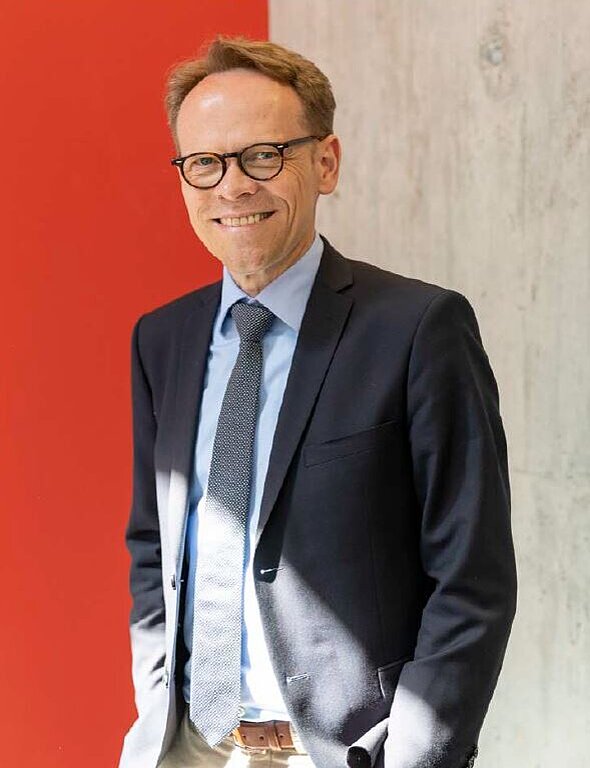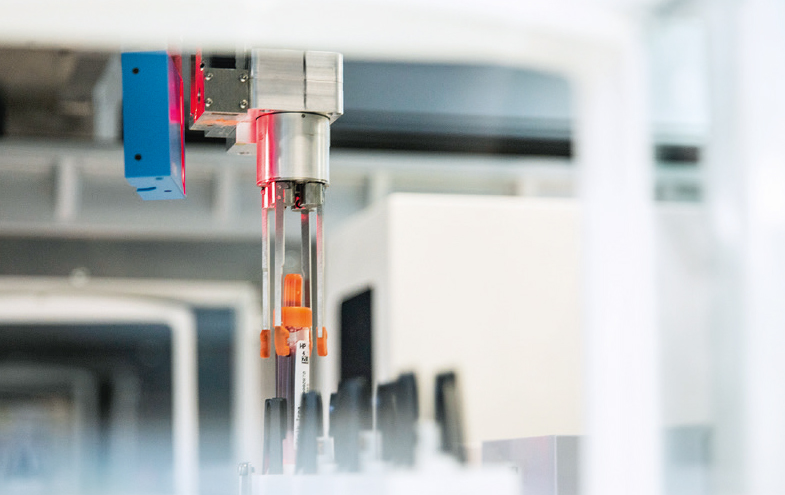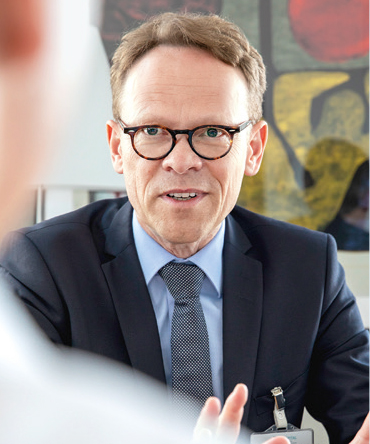‘Medicine is never just yes or no’
XTRA ARTICLE EDITION 2/2019
Prof. Dr Martin Fiedler, Medical Director of Inselspital Bern, expresses some very pointed opinions about the future of laboratory medicine in this xtra interview.
Text: Stephan Wilk
Professor Fiedler, you are the Medical Director of Switzerland’s oldest hospital. What kind of professional career brought you here?
I initially trained as an internal specialist and nephrologist. For ten years I was active in the field of internal medicine and nephrology and thus worked as a classic doctor at bedsides. I then moved to Leipzig, where I developed an interest in laboratory medicine. I wanted to use the positive experience of this ‘fusion’ in Bern to bring things up to date.
What did you find in Bern?
When I arrived eight-and-a-half years ago, laboratory medicine still had a classical structure: one institute for clinical chemistry, one for immunology and one for haematology. I was the Director of the Institute for Clinical Chemistry, alongside two other directors. It was only a matter of time before we had to face up to the challenge of how you can bring together such a conglomeration under one roof. In 2014, we decided to found a ‘Centre for Laboratory Medicine’ (ZLM). Today, I am the director of this new centre that covers clinical chemistry, immunology and haematology. The academics are drawn from the three specialist disciplines, while the organisational-procedural work is handled by a management team. In addition, I have two further roles as the Director of the University Institute for Clinical Chemistry and the Medical Director of the overall Inselspital, which has more than 10,000 employees.
How many samples does the ZLM examine each day?
Around 4,500 samples, that is to say blood samples, as well as a multitude of related analyses. The Inselspital has been part of the Insel Group since 2016. This group has five other hospitals whose laboratories are served by the Centre for Laboratory Medicine.
The ZLM also stands for the merger of research and diagnostics…
A lot of things have developed from this initiative. The ZLM today is an important driving force behind research at the site. One of our first investments was in a mass spectrometer for use by the clinic and research. We also have the biggest clinical biobank in Switzerland and have established a ‘Clinical Genomic Lab’. This is responsible for all molecular diagnostic analyses from the fields of laboratory medicine, human genetics and pathology.

Is a lot of data collected here?
Last year we founded the ‘Insel Data Science Center’ so that all of the data collected in the hospital and research could be put to good use. And we recently opened the ‘Center for Precision Medicine’, whose aim is to offer the patients the right therapy at the right time – that’s the future of medicine.
Has the ‘fusion’ within laboratory medicine been taken as an example for the rest of the Inselspital?
Definitely; we are currently in the process of reorganising the entire hospital. An organisational division into individual clinics and institutes is no longer in keeping with the times. We are the first hospital in Switzerland to bring together laboratory diagnostics and imaging in one medical sector. People always think that things happen slowly in Bern, but that’s not true.
How do you manage innovation in a rather conservative environment?
The Inselspital is the oldest enterprise in Switzerland, it was founded in 1354. So, what do I have to do if I want to digitise a highly conservative environment? Two things: change the structure, in other words come up with a new shell, and then change the organisation within this shell. Only then can I start work on the innovations. At the moment, we are converting parts of the Inselspital and adding some new buildings to house our digitisation project.
We will receive more and more customer-driven diagnostics. Diagnostics will be brought as close as possible to the patients.
Is the world of today’s diagnostic laboratory undergoing a greater change than ten years ago?
We will now see a rapid change. Ten years ago we experienced the typical effects of industrialisation. A competition broke out around automation. But what a lot of people forgot was that there was also an economisation of the field. A number of even large hospitals lost sight of the intrinsic added value of laboratory diagnostics and began to outsource these services. The objective was to keep costs low.

You are speaking in the past tense?
I believe that we will see the opposite effect in 20 years’ time. Large laboratories will decline and diagnostics will be brought as close as possible to the patients. We are already seeing a miniaturisation of the equipment and devices. Complex analyses can now be performed close to the patient with miniature devices.
How should laboratory medicine deal with the new situation?
To begin with, it should take care to remain the master of the data, and to remain the field that knows what to do with the content of this data. All that a number of our staff do is consider how we will deal with data in future. Digitisation will bring about a radical change in laboratory medicine, that’s for sure. I am positive about this development. This is something that people often do not like to hear when I speak at congresses.
Digitisation has reached the laboratory. What does this mean for laboratories, hospitals and patients?
Digitisation has not reached the laboratory yet. That’s the problem! It will get there at some point, but it hasn’t arrived yet. The surroundings have changed radically. Up to now, medical technology developments have come from medical technology companies. Nowadays, they are not alone in this field. For example, who makes medical smart watches? Those companies that have been pressing ahead with digitisation over the past years: Apple, Google, Amazon. If we’re not careful, the development will take place outside the world of medicine. One personal example: I wanted a smart watch that measures the heart rate variability for when I go jogging, and happened to come across a model that sends the data to Amazon. And their analysis is rather good!
But surely the layman has to come back to you for an explanation of the data?
There’s a good opportunity in making this data more understandable and easier to interpret by the patient. This is a field that laboratory medicine has to cover too – if it misses this opportunity and keeps concentrating ‘solely’ on analytics and its precision and efficiency in future, this is a service that will be offered by Google & co. in future.
What do the ‘digitals’ do differently?
We recently had a visit from the boss of Apple Health and talked about how Apple is tackling digitisation in hospitals. They begin by giving patients an iPad and asking them what they want to know. In this way, they create an emotional bond and accelerate the trend towards more and more ‘customer-driven diagnostics’. The focus is on the patient.
… and they collect their own figures!
If I measure personal data every day over a longer period of time, the added value is greater than if I go to see a doctor every two years. And if I configure the right settings for data and vital functions, this gives me a keen sense of whether something is on inside my body.
You work with biobanks too. Which effects can they have on research?
A multitude! It used to be that you had an idea for a certain research, submitted an application, recruited your patients, collected the samples – and could start the first experiment after a period of three years. If we manage to set up interconnected biobanks in the big hospitals in Switzerland, all we will have to say in future is: I’ve got a new marker for this disease – where can I find samples to test it on? Biobanks can accelerate research and make it less expensive.
Are laboratories turning into data factories?
I hope so, because I believe that big data is a great opportunity for the subject. Laboratory medicine has the technologies: molecular diagnostics, genomic diagnostics, as well as flow cytometry and mass spectrometry. Like this, diagnostics can become really exciting!

So all is not yet lost …
Laboratory medicine still has a big advantage at the moment: We are closer to the patients, Silicon Valley isn’t as yet.
IBM embarked on this kind of course with Watson, but things didn’t really work out.
Industry’s algorithms cannot be transferred one-on-one to medicine and its problems. Biologically or medically trained persons are needed to analyse this kind of data. Medicine is never just ‘yes’ or ‘no’. I prefer the definition given by William Osler, the Canadian medical historian: ‘Medicine is a science of uncertainty and an art of probability.’
Summary
- The fusion of laboratory diagnostics and research in the Inselspital Bern sparked off an overall, successful reorganisation.
- Digitisation has not yet reached the laboratory, but more and more data companies are forcing their way into the field of diagnostics. Laboratory medicine has to make sure it retains the prerogative of interpreting health data.
Photo: Thomas Eugster
